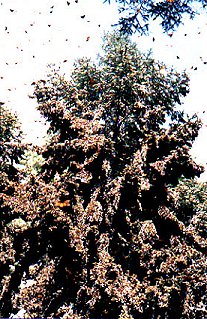
The adult butterfly
|
During it's first few days the butterfly nectars very little and has limited activity. Butterflies taste with their feet! They have a long, straw-like tongue called a "proboscis" which unrolls to suck up nectar when the butterfly's feet "tell" them they are standing on something tasty! The butterfly's only diet is nectar for energy, and there is no growth in the butterfly stage. |

| Male Monarchs have black circle-dots on their bottom set of wings, and their long, slender bodies have claspers at their rather pointy end. Female Monarch's wing veins are wider than the male's. The female's body is rounder and plumper than the male's, and its body is rounded at the end. Pairing occurs in the butterfly's first 7-10 days of life. The males initiate breeding by emitting pheromones, or mating hormone attractants, from those black spots on their wings!
The female Monarch is born with eggs inside of her body. After successful pairing, the eggs are fertilized as the spermatozoa enter the eggs through a small opening at the egg base. The female Monarch lays her eggs on the milkweed plant and no other, as it is the only plant the caterpillars will eat! In flight, Monarchs can radar-in on milkweed plants as far as five miles away! When her feet touch a milkweed plant, the female Monarch will usually curl the end of her body under the leaf and begin laying eggs that instant. |

|
In the wild, the Monarch's survival rate is about 3%. The survival rate for lab-raised butterflies can be as high as 95% with proper sterilization methods and disease preventative measures in place. Monarch butterflies live anywhere from two to five weeks. |
|
Trivia: the non-poisonous Viceroy butterfly (Limenitis archippus) mimics the colors of the Monarch and thus gains some associative protection. Birds that have eaten a Monarch butterfly have subsequently been observed to avoid both Monarchs and Viceroys. |
|
Monarch butterflies are the largest and most spectacular of the world's migratory butterflies. In the spring, Monarch butterflies migrate northward from their over wintering sites in Mexico and California, laying eggs all the way to Canada. In the late fall, Monarchs migrate southward back to their warmer over wintering sites. This last generation of Monarchs in the season is "programmed" to live much longer, often up to five months, in order to make the journey to the over wintering site and live to mate and create another cycle of Monarchs. |
|
Trivia: some North American Monarchs have been blown as far as Europe, and over 300 individuals have been recorded in the British Isles in the last 50 years. |
|
Migrating Monarchs fly by day, resting overnight in their thousands on trees. |
 |
 |
| Trivia: Not all Asclepias hostplants contain the cardiac poisons that Monarchs depend on for their protection, and adult Monarchs are only poisonous if the caterpillar fed on a poisonous variety. Even then, not all predators are put off, and large numbers of butterflies are eaten in their overwintering sites in Mexico. Jays and orioles have learned to discard the poisonous wings, and black-headed grosbeaks will eat the whole butterfly. |
| More information about the fascinating Monarch migration is provided in the Monarch Migration Study section, or at www.monarchwatch.org. |

